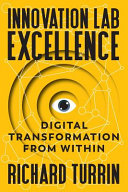Innovation Lab Excellence

Innovation Lab Excellence dives past the slick surface of espresso machines, youthful techies and creatively designed co-working spaces to examine, in detail, the conditions and practices necessary for a lab and innovation to initiate and thrive.
This book goes behind the scenes of working innovation labs to distill a rigorous set of best practices. Apply these to unleash the innovation that will give your enterprise a digital competitive advantage.
Written by an award-winning expert in financial technology and global manager of multiple labs.
This guide pulls no punches. It offers expert analysis of the most typical problems, and their solutions, so that your innovation can transcend the hype and achieve tangible results.
- This book reveals:
How innovation labs went from exotic add-ons to must-haves, and the unique challenges they face; - How a detailed array of best practices will help your lab excel and be better focused to serve your business interests;
- How a human-centric focus is the key to adopting new technology, and to gaining acceptance of both innovators and innovation;
- Where you need to rethink what you know about adopting new technology.
Innovation Lab Excellence is a must read if you manage an innovation lab, work in one, or are a business manager engaged with one.
The lab manager and employees are first on the list. They understand their lab’s challenges better than anyone else but need a guide that can act as an independent point of reference. Something that they can point to, or reference a chapter from, that will help them explain that they are not alone when they voice a concern or tackle a problem.
This book is also of great benefit to senior executives overseeing the lab. This might include the CEO who funds it, the Chief Innovation Officer (CINO) who oversees it, or the CIO that fumes about the lab wrecking his systems. All need to understand the practical realities of the innovation business, as it is most likely a new experience. Simply put, managing an innovation team is different.
Finally, and with probably the greatest amount of empathy, this book was written for the business unit leaders who may never have heard of an innovation lab before and are now being asked to work with one. They are the ones being asked to make the biggest cultural leap. They have to take products or services that they have invested a lifetime in perfecting and use technology to disrupt them.

